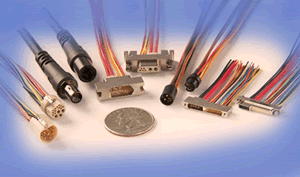Mil/Aero Applications: Flat-Lead or Round-Lead Connectors?
Connector-pin design has been caught up in a race to meet the needs of an ever-broadening range of applications, but military and aerospace applications have very serious environmental requirements that must be met first.

SWaP connectors with power and high-speed signals
We often look at a device and wonder, “Would the best connector for my design use a flat pin or a round pin and socket?” Other times we automatically plug a flat-pin connector into our phone or latch a round-pin connector into the panel of an instrument because it was designed that way. Military and aerospace system designers must review the myriad of applications and electronic questions of how their systems will be used and what kind of electronic signals they will process. Cabling between units is also a key consideration.
The history of Fire Wire and the IEEE-1394 cable specifications is a fascinating demonstration of our rapid evolution in higher-signal processing and the broadening use of electronics in our lives. Connector-pin design has been caught up in that same race with an ever-broadening range of applications and electronic signal techniques coming and going from today’s many new devices, but military and aerospace applications have very serious environmental requirements.
A designer must review his applications to decide how the format fits within his industry and interfaces with other equipment. Consumer electronics for home and personal devices are pre-defined because connector types are often pre-determined by the devices we purchase in retail stores. Industrial and military equipment, however, are different. Surveillance systems often require high-speed digital transmission and on-board power to the scanning devices. Aircraft and other life-support systems require isochronous data transfer with continuous bandwidth to ensure constant signal support from transducers and detectors for safety. Military robotic applications most often want miniature size, extreme flexibility, and small-diameter wiring as well as rugged construction to allow for continuous motion.
Connector designers must also focus and weigh the pros and cons of many discrete elements such as voltage level and current applications. Pin-and-socket systems seem to handle much higher voltage and current levels and can be designed to offer low impedance matching when needed. Flat pins can be designed with low capacitance from pin to pin and are often used for the 100-ohm-impedance portable instruments we use in homes today. Although both flat and round pins do very well in their respective applications, we tend to rely on pin-to-socket systems for ruggedness and resistance to shock and vibration. These environmental demands become critical in highly portable electronics for use in missile design, ground troop electronics, and systems used in deep space, such as the Mars Rover.
Pin-and-socket connector manufacturers use special metal alloys to ensure pin-to-socket retention through high vibration, temperature changes, and other environmental situations. Each individual pin and socket is plated to military-level specifications to extend the number of mating and un-mating events it can provide. Flat-lead connectors depend more heavily on plastic shells and molded polymers to hold their leads in position during mating and use. Both methods, however, seem to work well in their own markets.
Flat-lead connectors have led the way in lower-cost assembly and automated termination to cable. Higher volumes with these flat-pin systems also have reduced significantly the cost of flat-lead connectors. As techniques evolve, we will see more flat lead connectors in military systems but mostly within larger systems and more stabilized instruments.
Military and aerospace circuit designers should also remember that using USB techniques may require instrumentation with bus-driver circuits for the host cable and connectors. Many pin-to-socket systems on IEEE-1394 cable can be used as-is with most systems and run directly from instrument to device without additional electronics. Recently, we’ve seen more multiple high-data-rate bus signaling systems that offer significantly faster and better data streaming on cable systems using flat-pin HDMI-type interconnects. In these applications, additional shell and latching will be required to ensure constant in-line signal integrity for highly portable and rugged applications. Metal shells and heavily shielded cabling will be needed to ensure cyber security from inductive coupling techniques.
More exotic electronic systems such as Gigabit Ethernet focus on cable designs that often carry multiple digital channels simultaneously and require fairly high power. Large standard systems often have specialty system interconnects to handle the data and use parallel power pin-to-socket connectors for the high current demand. We now see newer portable Ethernet systems and high-performance military radios that require the combination of power and higher-speed signal integrity within one connector and cable system. These very rugged, very portable systems have generated the newer military term “SWaP” (size, weight, and power). Small and lightweight power hybrid cable and connectors are built into one customized flexible unit using standard elements and materials. This newer version of highly portable connectors is available in both circular and rectangular micro and nano sizes and can include latching methods for fast plug-and-process equipment.
Pin-and-socket contacts are used to survive extensive environmental exposure and thousands of mating cycles. Pin-and-socket systems are more rapidly designed using solid modeling, insulator molding, and automated metal-shield fabrication using CNC machines connected directly to solid modeling equipment. The result is fast-turn, ruggedized, hybrid connectors and cable that use strong pin-to-socket connectors to handle both high-speed digital electronics and higher power to and from the portable equipment. Fast-turn-to-market, application-specific connectors are solving major system development needs.
Author Bob Stanton is the director of technology at Omnetics Connector Corp.




